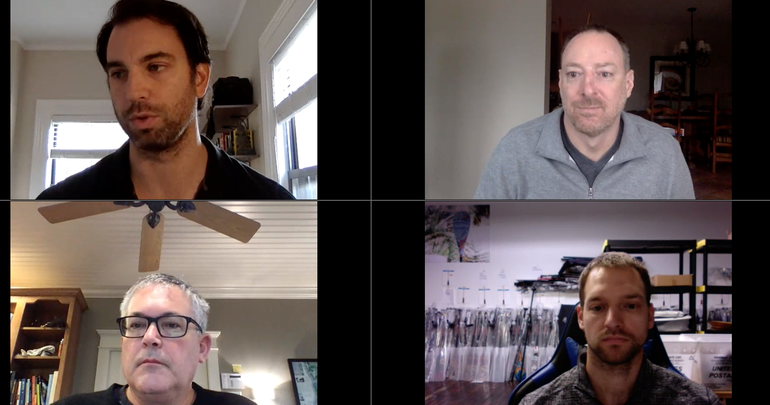MITC panel: Pandemic-driven e-commerce pivots are likely here to stay
 Screenshot / Courtesy, Maine International Trade Center
From top left, Nate McCraven, director of business development of iBec Creative in Portland and a founding member of the Maine Ecommerce Collective, moderated a panel that included Keith O’Brien, a principal of business consulting firm HarborHouse Partners in Blue Hill and CEO of Page.One; Vince Kott of Hornet Watersports in Biddeford; and Brendon Reay, a principal of HarborHouse Partners in Blue Hill.
Screenshot / Courtesy, Maine International Trade Center
From top left, Nate McCraven, director of business development of iBec Creative in Portland and a founding member of the Maine Ecommerce Collective, moderated a panel that included Keith O’Brien, a principal of business consulting firm HarborHouse Partners in Blue Hill and CEO of Page.One; Vince Kott of Hornet Watersports in Biddeford; and Brendon Reay, a principal of HarborHouse Partners in Blue Hill.
For many businesses, the pivot to e-commerce during the pandemic has been a big lift.
The question for the future is whether they’ll continue to maintain their new e-commerce presence into the future.
“It’s a little hard to say without the crystal ball,” said Keith O’Brien, a principal of business consulting firm HarborHouse Partners in Blue Hill and CEO of Page.One, a Dania Beach, Fla., marketing firm specializing in Amazon listings.
But, he continued, much of the shift to e-commerce is here to stay.
“I think we’ve seen some culture shifts,” he said.
O’Brien was speaking at an Oct. 22 webinar hosted by the Maine International Trade Center in Portland, or MITC, and the Maine Ecommerce Collective on e-commerce strategies.
According to MITC, global e-commerce sales are expected to top $4.2 trillion in 2020 and reach more than $6.5 trillion by 2023. More than 2.1 billion shoppers are expected to buy goods and services online by 2021. Increasingly, online shoppers live outside the U.S. The webinar was designed to share long-term e-commerce strategies to reach the growing online international audience.
While many companies already had robust e-commerce platforms before the pandemic, the health crisis has forced others into “new habits,” said O’Brien.
By one estimate, a decade’s worth of market share was gained in 90 days by e-commerce during the pandemic, said Brendon Reay, another principal at HarborHouse Partners.
“It’s just phenomenal when you think about that,” Reay said. “And it’s here to stay. It’s only getting bigger.”
24/7 operation
The challenge for business is not the shift to e-commerce per se, Reay continued, but how owners continue to manage their businesses in the new digital reality. That includes considerations such as supply chain management, preparation of product or service lines, and advertising and marketing.
“It’s a 24/7/365 operation,” he said.
Devin Temple, a lead digital marketer at iBec Creative in Portland and a founding member of the Maine Ecommerce Collective, said there are numerous considerations for developing a successful e-commerce platform. That includes comparing platforms, such as WooCommerce, Shopify and Magento, which can range from being relatively simple and inexpensive to more expansive. Other factors include payment portals, shipping and integration with multiple shipping providers, translation for international customers, and integration with advertising platforms such as Facebook ads.
From a broader perspective, the current impact of e-commerce in today’s markets revolves around which categories are successfully weathering the pandemic, said O’Brien.
Categories related to travel “are just not happening in today’s marketplace,” he continued. Others are doing well, he said, citing liquor makers who turned to making hand sanitizer, as well as products for the home.
“Anything contributes to making life easier, more enjoyable, more fun at people’s homes, those things have seen massive upticks,” O’Brien said.
The Amazon factor
The wake-up call, for brands that sourced most of their revenue in retail, is that they’ve had to switch to e-commerce or make their e-commerce presence bigger, he said.
Speakers said Amazon is likely an unavoidable player as a third-party marketplace.
“It’s hard to ignore it now,” said O’Brien, who noted that he has a vested interest in the topic as a consultant for Amazon-listed businesses.
Amazon today represents about 40% of the e-commerce marketplace, O’Brien said.
“It’s such a huge part of the fabric of e-commerce,” he said, noting that it’s also likely one of the least expensive ways to launch a new product to the marketplace.
Amazon can be a valuable marketplace as part of a company’s overall strategy, which might include other online and physical marketplaces, he continued.
“It just becomes an allocation of resources,” he said
Vince Kott, who owns Hornet Watersports, a designer of custom paddles for watercraft in Biddeford, noted that, while e-commerce is growing and represents a new world of opportunity for many businesses, it’s also competitive and requires constant innovation.
Side hustles are over
Launching a successful e-commerce platform is more complicated today than it was just five years ago, said O’Brien.
At that time, it was pretty easy for a company that sells just a couple of products to find their niche in the e-commerce marketplace and make some money.
“The days of having a side-hustle e-commerce business with two or three products that do consistently well are beyond us,” he continued. “What works now is having a little bit bigger, deeper catalogue.”
That way, he said, when one part of the catalogue dips, other products are available to make up for the loss.
“You’re looking at your business as a catalogue play rather than two or three products to drive sales,” he said. “That means businesses need more money. They’ve got to plan better and get a little more aggressive.”
That includes good digital marketing — good copy, photography and design — and being prepared for an extended marketing rollout, he said.
“If you do that, you’ll at least know whether you have something successful,” he said. “If you don’t, you don’t know if you have a winner or not.”













0 Comments